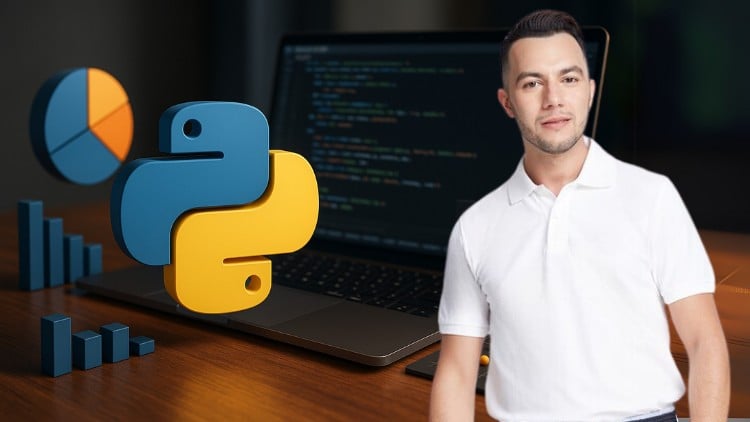
Master data analysis, machine learning, data visualization, and project workflows using Python no experience needed.
⏱️ Length: 22.5 total hours
⭐ 4.40/5 rating
👥 11,221 students
🔄 June 2025 update
Add-On Information:
Note➛ Make sure your 𝐔𝐝𝐞𝐦𝐲 cart has only this course you're going to enroll it now, Remove all other courses from the 𝐔𝐝𝐞𝐦𝐲 cart before Enrolling!
- Course Overview
- Embark on a comprehensive journey into the dynamic world of data science, leveraging Python as your primary tool. This course is meticulously crafted to transform complete beginners into confident data practitioners.
- Explore the fundamental concepts of data manipulation, statistical analysis, and predictive modeling, all through hands-on coding exercises and real-world scenarios.
- Uncover the intricate lifecycle of a data science project, from initial data acquisition and cleaning to sophisticated model deployment and interpretation, equipping you with a holistic understanding.
- Gain proficiency in Python’s robust ecosystem, specifically tailored for data-centric tasks, fostering an intuitive grasp of how code translates into actionable insights.
- Delve into the art of extracting meaningful patterns from raw data, understanding cause-and-effect relationships, and making informed, data-driven decisions that propel innovation.
- Learn to approach complex problems with a data scientist’s mindset, focusing on methodical problem-solving and critical evaluation of results.
- Requirements / Prerequisites
- Absolutely no prior programming experience is necessary; this course is designed from the ground up for individuals new to coding and data science.
- A basic understanding of computer operations and internet navigation is all that’s required to get started on your learning path.
- Possession of a personal computer (Windows, macOS, or Linux) capable of running standard web browsers and Python development environments is essential.
- A stable internet connection for accessing course materials, online resources, and potentially cloud-based development tools will be beneficial.
- An eagerness to learn, a curious mind, and a willingness to practice coding concepts regularly will be your greatest assets for success.
- No specific software needs to be purchased; all necessary tools are free and open-source, and guidance for their installation will be provided.
- Skills Covered / Tools Used
- Foundational Python Programming: Master core Python syntax, data structures (lists, tuples, dictionaries, sets), control flow, and functions specifically in the context of data manipulation.
- Numerical Computing with NumPy: Develop expertise in using NumPy arrays for efficient numerical operations, vectorization, and fundamental linear algebra essential for scientific computing.
- Data Manipulation and Analysis with Pandas: Gain proficiency in using Pandas DataFrames and Series for robust data importing, cleaning, transformation, merging, grouping, and aggregation of complex datasets.
- Effective Data Visualization with Matplotlib and Seaborn: Learn to create compelling and insightful static data visualizations, including scatter plots, bar charts, histograms, box plots, and heatmaps, to communicate findings clearly.
- Machine Learning Fundamentals with Scikit-learn: Understand the principles of supervised learning (regression, classification), unsupervised learning (clustering), model training, prediction, and basic evaluation metrics.
- Statistical Analysis Techniques: Apply descriptive statistics to summarize data and inferential statistics to draw conclusions about populations based on samples, using Python’s statistical libraries.
- Feature Engineering and Selection: Explore techniques to create new features from existing data and select the most relevant features to improve the performance of machine learning models.
- Introduction to Data Cleaning Best Practices: Implement strategies for handling missing values, identifying and treating outliers, and standardizing inconsistent data formats to ensure data quality.
- Data Storytelling: Learn to construct a narrative around your data findings, presenting insights in a logical, understandable, and persuasive manner to diverse audiences.
- Basic Algorithmic Thinking: Develop a problem-solving mindset by understanding how to break down complex data tasks into manageable steps and implement efficient algorithms using Python.
- Working with Different Data Formats: Practice loading and saving data from various sources such as CSV, Excel, JSON, and potentially interacting with basic SQL databases.
- Jupyter Notebooks: Utilize Jupyter Notebooks as an interactive development environment for coding, documenting, and presenting your data analysis workflows effectively.
- Benefits / Outcomes
- Acquire the practical skills to confidently perform end-to-end data analysis, from raw data acquisition to insightful conclusion.
- Develop the capability to build, evaluate, and interpret various machine learning models for predictive analytics, making data-driven forecasts.
- Master the art of creating impactful and aesthetically pleasing data visualizations to effectively communicate complex information to stakeholders.
- Cultivate a strong problem-solving acumen, enabling you to identify and address real-world challenges through data-centric approaches.
- Formulate logical arguments and support decisions with empirical evidence derived from rigorous data analysis and statistical validation.
- Establish a solid foundation in Python’s data science ecosystem, preparing you for advanced topics or specialized roles in the field.
- Gain the confidence to tackle diverse datasets, clean messy information, and extract valuable patterns that might otherwise remain hidden.
- Be capable of translating business questions into data science problems and subsequently converting data insights back into actionable business recommendations.
- Develop a portfolio of practical projects demonstrating your proficiency in Python for data analysis, machine learning, and visualization, showcasing your applied skills.
- PROS
- Highly rated and widely recognized by a large community of learners, indicating proven instructional quality.
- Content is regularly updated, ensuring relevance with the latest industry tools and best practices as of June 2025.
- Designed specifically for complete beginners, offering a gentle yet thorough introduction to complex topics.
- Comprehensive coverage of essential Python libraries (NumPy, Pandas, Matplotlib, Seaborn, Scikit-learn) for a well-rounded skillset.
- Practical, hands-on approach with numerous exercises and real-world examples to solidify understanding and application.
- Empowers students to build a strong foundational understanding crucial for further specialization in AI, ML, or data engineering.
- The structured curriculum helps learners grasp the entire data science workflow efficiently within the specified duration.
- CONS
- While comprehensive, mastering data science requires significant personal practice and continuous learning beyond the course material.
Learning Tracks: English,IT & Software,IT Certifications
Found It Free? Share It Fast!